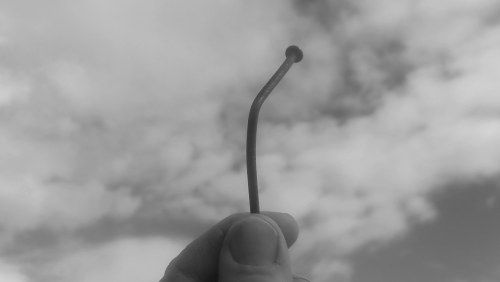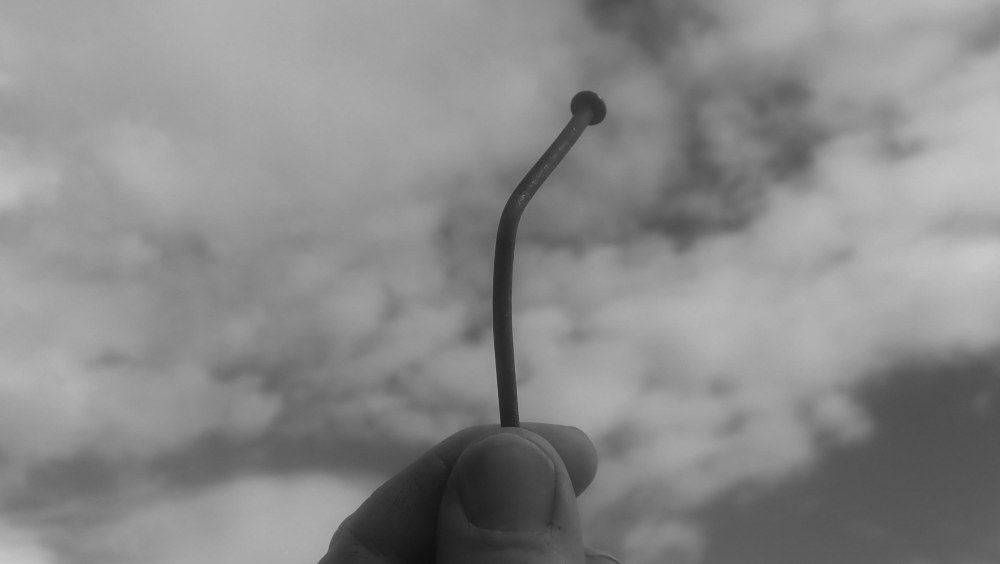The Joy of Recycling One Nail
—

“The quest to recycle everything, or avoid buying it in the first place, is a lifelong journey, one where the end goal seems both incrementally closer and infinitely far away.”
Rationally speaking, it is admittedly futile. Why worry about recycling one rusty nail when other people seem callous to recycling anything? What’s one nail compared to two huge dumpsters overflowing every week with unsorted recyclables mixed with garbage? Cardboard, aluminum cans, tin cans, copper wires, and recyclable plastics… people pitch it in the dumpster along with equally recyclable scrap metal and easily compostable kitchen scraps and lawn clippings. It is shocking how much waste we generate in my community of just 250 people. It is sad how many recyclables are discarded with the trash when there are recycling bins conveniently located at the dumpster site. Extrapolating from our tiny rural community to the colossal mountains of trash generated nationally in a country of 325 million people, the waste is inconceivable, beyond imagination. Why would anyone keep trying?

A couch or recliner is almost entirely recyclable.
Nevertheless, I carry on. I’ll wipe out a metal paint bucket and dry the can before recycling it as scrap metal. I poke holes in the bottom of empty aerosol cans with the can opener on my pocketknife, releasing any residual gasses, while pointing the can away from myself for safety. For insurance, I wear safety glasses. If the aerosol can is spray paint, I completely remove the bottom of the can to extract the glass marble inside. Then it is a simple matter to dry the can on the woodpile before smashing it flat with the back of the ax to recycle with other tin cans.
I’ll go the extra mile to recycle anything that can reasonably be recycled while pondering how to recycle whatever trash is leftover. A couch, for example, is almost entirely recyclable. After disassembly, all metal bolts, springs, and plates can be recycled as scrap iron. A five-gallon bucket is handy for collecting random bits of metal. Any untreated wood can be cut up for firewood, extracting warmth for the house while reducing the need for fossil fuels. The fabric covering can be washed and dropped off at Goodwill stores to be shipped out for sale to the rag market. The remaining foam pads make great sponges, easily cut to any shape or size, eliminating the need to buy big cleaning sponges at the store.

I dismantled a trailerhouse for recycling and successfully re-used about eighty percent of the materials.
In addition to saving natural resources from the waste stream, recycling provides a unique opportunity to consider green business opportunities working with recycled content. For example, a trailerhouse is built for temporary use and disposal, a poor use of natural resources. Most trailerhouses are ultimately bulldozed and landfilled. I once dismantled a trailerhouse for recycling and successfully re-used about eighty percent of the materials. Clean fiberglass insulation went in the attic of an adjacent building to conserve energy. The aluminum siding and copper plumbing and wiring went to the recycling center. Wood paneling was cut into nine-inch-wide strips on a table saw and screwed to the salvaged 2 x 3s to make formwork to pour the foundation of a new house built to replace the trailerhouse. The metal frame underneath the trailer was reconfigured and welded together as a deck on the back of the new house. Recycling the trailerhouse removed it from the jobsite without paying to haul it away. I also saved hundreds of dollars in materials costs.

I’ve bounced around ideas for starting green businesses with free recycled glass, free tires, free barbwire, free wood, free rocks, free cinderblocks, free insulation, free deer hides, and dozens of other possibilities.
I see other decaying trailerhouses where landowners truly don’t know what to do with them. It occurred to me that anyone looking for work could knock on a few doors and offer to dismantle and recycle these old trailerhouses for a modest fee, less than hiring someone to haul the structures off to the landfill.
I’ve bounced around ideas for starting green businesses with free recycled glass, free tires, free barbwire, free wood, free rocks, free cinderblocks, free insulation, free deer hides, and dozens of other possibilities. Writing and publishing is career enough, but we incorporate recyclable content where possible, such as recycled paper for printing. For shipping wholesale orders, we salvage cardboard boxes and packing material from dumpsters, conserving natural resources and hundreds of dollars every year.
Most resources are recyclable in one form or another. I use a screen to sift nails out of the ashes from the woodstove. The nails go into a scrap metal bucket for recycling while the remaining ashes are distributed in the pasture for nutrients. Even used kitty litter is a valuable resource, scattered in the pasture to add water-holding clay particles to the sandy soil. All food scraps go to the chickens. Tree trimmings are used in landscaping projects. Woodchips from chopping wood are added to mulch piles to retain moisture for planting trees. Nothing organic is thrown away.

Everything purchased must necessarily meet its end somewhere, either composted, recycled, or landfilled—mostly the latter. Whole hot tubs are dropped in the community dumpster, as are whole boats, some nearly dumpster-sized themselves.
Through the recycling effort I learned that the most efficient means to recycle is to avoid buying disposable junk in the first place.
Everything purchased must necessarily meet its end somewhere, either composted, recycled, or landfilled—mostly the latter. Whole hot tubs are dropped in the community dumpster, as are whole boats, some nearly dumpster-sized themselves. Through consciousness of recycling I’ve developed an aversion to buying anything new. I buy about one item of new clothing per year, purchasing the rest secondhand. Good clothes gradually degrade into work clothes, which further degrade into rags, or in the case of cotton jeans, become char cloth used for flint and steel fire-starting in our wilderness survival programs.
It is still disconcerting how much trash I haul off to the dumpster, the twinge of guilt lessened by the fact that most of my trash originated at the dumpster. Today, for example, I discarded a clear plastic tarp, remnant of a larger sheet I hauled out of the dumpster a year ago and used for multiple projects. The garbage can was full of hanging plastic flower pots which I brought home to salvage the potting soil and organic matter, returning the unneeded pots back to the dumpster from whence they came.
The quest to recycle everything, or avoid buying it in the first place, is a lifelong journey, one where the end goal seems both incrementally closer and infinitely far away. By processing roadkill deer, I get free organic venison while avoiding those annoying Styrofoam trays that come with store-bought meat. Packaging the venison in bread bags doubles the use of the bags and eliminates the cost and consumption of purchased wrapping paper.

We’ve squandered our natural resources in an orgy of consumption, impoverishing the world for the next generation.
While inching ever slowly towards the goal of recycling everything and eliminating all waste, I have to admit that my efforts are arguably meaningless in context of the waste that defines our culture. Why trouble myself to clean and save every tin can, aluminum can, plastic bottle or glass jar when other people thoughtlessly dispose of natural resources by the truckload? Why recycle a used compact fluorescent light bulb or the brass fitting from the end of a garden hose when other people don’t seem to care?
Do they not have children? It is difficult to comprehend how any parent or grandparent could carelessly dispose of a child’s future in a landfill. By any reasonable measure, we’ve squandered our natural resources in an orgy of consumption, impoverishing the world for the next generation.
Many people have given up already, not bothering to recycle only because no one else is. What’s the point? Industrial civilization must inevitably collapse they say, because we are consuming ourselves out of a planet. Recycling only delays the inevitable. Why bother trying to save civilization when it is demonstrably unsavable? By any reasonable measure, the future is a lost cause, and our children are doomed. Give up now, enjoy life, and quit worrying about the issue. Forget the nail and chuck it in the garbage.

Although a miniscule amount of metal, a bent and rusty nail can be melted down and fashioned into a new nail. Recycling one nail immediately saves one itsy-bitsy-teensy-tiny piece of the planet that won’t be mined.
Yet, I cannot. It is a nail after all. Although a minuscule amount of metal, a bent and rusty nail can be melted down and fashioned into a new nail. Recycling one nail immediately saves one itsy-bitsy-teensy-tiny piece of the planet that won’t be mined and refined because market forces registered the creation of a replacement nail through recycling instead. In a world of chronically bad news, there is something microscopically heroic about saving a cubic centimeter of a mountain.
In addition to saving a small piece of the world, recycling ensures that there will be resources for the next generation. If nothing else, there will be at least one nail for our children’s children, and one nail is infinitely more useful than no nail at all. Imagine then, recycling two or three nails, or a thousand.
“Recycling a nail may seem an inconvenience. Yet, to dispose of a nail requires a far bigger inconvenience, for one must also deconstruct the reality of hope.”

At a time when humanity often seems Hell-bent on its own destruction, recycling is a small act of hopeful defiance.
Recycling a nail may seem an inconvenience. Yet, to dispose of a nail requires a far bigger inconvenience, for one must also deconstruct the reality of hope. A world without recycling is a world without a future, whereas recycling is an act of faith and hope that there will be another tomorrow. And where there is hope there is joy.
Hope is a particular kind of joy. It is the joy of rebounding from a bad situation towards a better one, when hope seems lost then is restored. At a time when humanity often seems Hell-bent on its own destruction, recycling a nail is a small act of hopeful defiance.
Much like planting a tree for one’s grandchildren, recycling is the act of giving something back for tomorrow. Faith in the future is implicit. That is the irony of the iron nail, for most of the world’s problems are easily solved. Recycling reduces resource extraction, pollution, and waste to ensure a better tomorrow. The more we recycle, the more reason there is to be hopeful about the future. And that is something to be truly joyful about.
Thomas J. Elpel is the founder of Green University® LLCand the author Green Prosperity: Quit Your Job, Live Your Dreams, and numerous other books about nature and sustainable living.
– Come Like Us on Facebook – Check us out on Instagram –
– Sign Up for our Newsletter –
Subscribe to our New NOW Youtube Channel




 thomasjelpel.wordpress.com
thomasjelpel.wordpress.com








